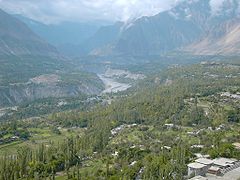| Revision as of 17:17, 16 January 2019 editWereSpielChequers (talk | contribs)Bureaucrats, Administrators343,521 editsm Typo fixing, replaced: is is → is, typo(s) fixed: wouldn’t → wouldn't, author’s → author'sTag: AWB← Previous edit | Revision as of 09:35, 26 February 2019 edit undoKazmi (talk | contribs)Extended confirmed users944 edits The page has been improved. The page no more talks about district Nagar. Although it requires more improvement. Removing merge tag.Next edit → | ||
| Line 1: | Line 1: | ||
| {{Merge to|Nagar District|date=September 2017}} | |||
| {{Refimprove|date=December 2008}} | {{Refimprove|date=December 2008}} | ||
| {{Infobox settlement | {{Infobox settlement | ||
Revision as of 09:35, 26 February 2019
| This article needs additional citations for verification. Please help improve this article by adding citations to reliable sources. Unsourced material may be challenged and removed. Find sources: "Nagarkhas" – news · newspapers · books · scholar · JSTOR (December 2008) (Learn how and when to remove this message) |
| Nagar | |
|---|---|
 Hunza valley Hunza valley | |
  | |
| Coordinates: 36°16′36″N 74°43′10″E / 36.276776°N 74.719566°E / 36.276776; 74.719566 | |
| Country | |
| Administrative territory | Gilgit–Baltistan |
| District | Nagar |
| Elevation | 2,688 m (8,819 ft) |
| Time zone | UTC+5 (PST) |
Nagar (Urdu:نگر), also known as Oyum Nagar in Burushaski and Nagar Khas in Urdu, is one of the largest towns in the Nagar District in Gilgit–Baltistan. Situated on the bank of the Nagar river, it is the former capital of the princely state of Nagar.
Today, the famous Karakoram Highway crosses Nagar, connecting Pakistan to China via the Khunjerab Pass. The road follows the Hunza-Nagar River for some distance through Nagar and into the hunza region.
Location


Nagar lies in the Nagar river valley, about five miles south-east of the junction of the Nagar river with the Hunza river just below Baltit.
The Nagar valley previously known as Broshal, is situated at an elevation of 2,438m (7,999 feet). Nagar Khas is the main town and the capital of the former State of Nagar. Ghulmet, Minapin, BAR, Chaprote and Hopper Valleys are popular tourist attractions in the Nagar region because of the spectacular scenery of the surrounding and the most intimidating high mountain peaks on earth such as Rakaposhi at 7,788m (25,561 feet), and Diran, and Spantik peak also known as (Golden peak) and several others to be discovered.
History
Main article: Nagar (princely state)Following the Hunza-Nagar Campaign of 1889–1892 (known locally as the Anglo-Burusho war) the area passed under British control and then as a vassal of the Kashmir Durbar, but was ruled by the same royal family. In 1974, Zulfiqar Ali Bhutto dissolved the Princely States of Nagar and Hunza and gave democratic representation to the Northern Areas Council, now known as the Northern Areas Legislative Council.The British wanted to expand their trade to Russia from here, but the states wouldn't allow them to.
Royal titles and styles
The name for the ruler in Nagar was Thum (تھم) in Brushaski and (Ra-را) in Shina language, which is also a respectful appellation used by people of both Hunza and Nagar who belong to the clan of Boorish. The titles for prince and princess and the styles of Highness and Royal Highness for members of the Royal Family are still used here. In Hunza and Nagar Royal family men are called Gushpoor (گشپور) and Royal family women are titled as Soni (سونی).
References
- Nicolaus 2015, p. 225.
- Tilman, H.W. (2016), Two Mountains and a River: I made a resolve not to begin climbing until assured by a plague of flies that summer had really come, Vertebrate Publishing, pp. 119–, ISBN 978-1-909461-31-4
Bibliography
- Nicolaus, Peter (2015), "The Taming of the Fairies", in Uwe Bläsing; Victoria Arakelova; Matthias Weinreich (eds.), Studies on Iran and The Caucasus: In Honour of Garnik Asatrian, BRILL, pp. 225–, ISBN 978-90-04-30206-8
Further reading
- Leitner, G. W. (1893): Dardistan in 1866, 1886 and 1893: Being An Account of the History, Religions, Customs, Legends, Fables and Songs of Gilgit, Chilas, Kandia (Gabrial) Yasin, Chitral, Hunza, Nagyr and other parts of the Hindukush, as also a supplement to the second edition of The Hunza and Nagyr Handbook. And An Epitome of Part III of the author's “The Languages and Races of Dardistan.” First Reprint 1978. Manjusri Publishing House, New Delhi.
- Where three Empires meet by E.F.Night.
- Buroshall Say Nagar Tak ka Safar by Mohammad Ismail Tehseen.
- Brushaal Ke Qabail by Syed Yahya Shah
- Rakaposhi Nagar (راکاپوشی نگر) (Travelogue, 2015) by Mustansar_Hussain_Tarar
Categories: